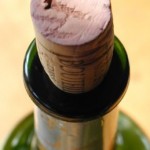So, you’ve been saving a nice bottle of wine for a special occasion. You open it, pour it, swirl the ruby-colored nectar in your wine glass and raise it to you lips. Suddenly, your nose screams at you to STOP! The wine you’ve so been looking forward to smells like funky wet newspaper, or maybe your dog after he got wet playing in a creek. What happened? Most likely it’s something called TCA, commonly known as cork taint.
TCA stands for 2,4,6-trichloroanisole, a powerful, naturally-occurring chemical that can cause wine to have musty aromas and flavors.  Natural corks are the most common source of TCA, which is how it often transfers to the bottle. This is why affected wines are sometimes referred to as “corked.” But so-called cork taint can also originate from other sources such as contaminated winery equipment. Barrels, wooden pallets, and cardboard cases –all common in wineries- contain plant phenols. These phenols, when combined with airborne molds and common chlorine-based cleaning products, can lead to the production of TCA.
Natural corks are the most common source of TCA, which is how it often transfers to the bottle. This is why affected wines are sometimes referred to as “corked.” But so-called cork taint can also originate from other sources such as contaminated winery equipment. Barrels, wooden pallets, and cardboard cases –all common in wineries- contain plant phenols. These phenols, when combined with airborne molds and common chlorine-based cleaning products, can lead to the production of TCA.
Though unpleasant, TCA is not a health threat for wine drinkers; the worst that can happen is that your expensive bottle of Cabernet Sauvignon will be ruined. Occasionally, at very low levels, TCA will affect a wine by essentially removing its flavor. A wine you might be expect to be big and fruity will taste bland without actually tasting bad.
Like many tastes (tannins, for instance) a drinker’s ability to perceive them varies greatly depending on genetics. Trained and experienced taste buds can also pick out more in a bottle of wine, so a sommelier, for instance, might detect TCA when a casual drinker might not.

There are different estimates as to how common TCA is in wine. The cork industry estimates 1 to 2 percent of bottles while other sources estimate 5 to 6 percent.
What does one do about cork taint? Not much. Wineries are being more cautious so incidences have decreased, but if you do get a tainted bottle, one solution might be polyethylene plastic wrap. Put a sheet of the plastic wrap in your wine decanter and add the wine. The polyethylene molecules attract TCA molecules and will essentially remove it from the wine within a few minutes. Other options? Return the bottle to where you purchased it, pour it out, or hold your nose, grin and bear it!
 October 21, 2013 | Posted in
October 21, 2013 | Posted in 


 serving suggestion is to
serving suggestion is to